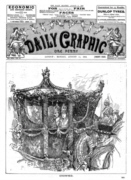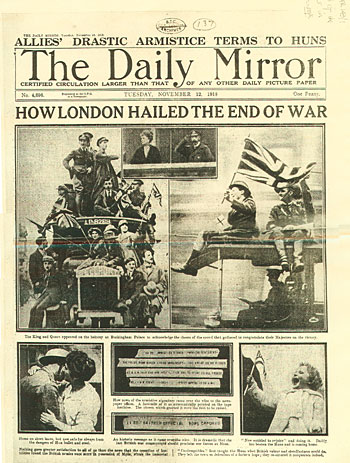
The Rise of Tabloids During the 1920s
During chapter two, readers often note how Fitzgerald frequently mentions the tabloids laying around Myrtle’s apartment. The Town Tattle and Simon Told Peter were two examples of the type of literature that Myrtle read. Since the books the characters read were very important to Fitzgerald’s characterizations, we can assume that Myrtle’s lower class origins are betrayed by her interest in these trashy publications. However, Fitzgerald never would put something in his novels that did not also reflect elements of the Jazz Age. During the years after World War I, an entirely new generation of scandalous lurid tabloids arose such as the New York Daily News, the Evening Journal, and the Daily Graphic.
These publications were part of a repeated cycle in American journalistic history. The trend started with the penny papers of the early 1800s, and was repeated at a larger scale during the “yellow journalism” period near the turn of the century. During this time William Pulitzer and Joseph Hearst did battle through their papers, stirring up controversies, most notably the Maine incident, which brought the U.S. into a war with Cuba.
However, these new tabloids had important differences that really helped to define the new era of journalism. One of the most important features was the smaller size of the paper, which is still seen in today’s tabloids. This smaller size allowed for brief but exciting stories that could capture the interest of the lower class markets towards which they were aimed. Established in 1919 by Joseph Medill Patterson, the Daily News used this smaller size, along with comics, personal columns, and a more personal reporting style to capture the imagination and money from the lower classes. For the first time, the gossip columns were placed right alongside news columns, indicating the real frivolity of the decade that Fitzgerald wished to portray in Myrtle.
However, the limits of tabloid reporting would extend far below that of the Daily News, whose circulation would top 1.3 million by the end of the 1920s. After the cynical period directly following World War I, another technique was exploited by the tabloid generation. This was the rapid increase of photography, at first in the tabloids but later in all periodicals. The photographs also catered to the same lower class population that enjoyed the shorter and more sensational articles. The Daily Graphic was the tabloid that took photography to new, but lower, heights. The self stated mission of the paper was aimed at individual improvement by the reader, and the editors frequently used confessions and created stories to try to accomplish this goal. Large and often graphic photographs also accompanied the stories, which helped sell papers during this period of “gutter journalism”.
The papers would frequently use articles chronicling wild parties and the young women who attended them. On a more serious note, tabloids would often unearth old murder cases and pressure the government to prosecute them, such as the Hall-Mills Case. In the Ruth Snyder trial, when she was found guilty of murdering her husband, the Daily News had the audacity to sneak into her execution by the electric chair and take her photograph. This type of reporting was characteristic of the time period and was used by Fitzgerald to characterize Myrtle and the people who went to her parties.
Some common tabloids of the 1920s. Note the graphic images on the covers.

Tabloids of the 1920s. 29 Jan. 2004 <http://mcco.lib.siu.edu/projects/jrn400/tabloids.html>
Shuman, James. The Rise of Tabloids in 1920s . 29 Jan. 2004. http:/coolschool.k12.or.us/curses/190200/lesson2/riseoftabloids.html